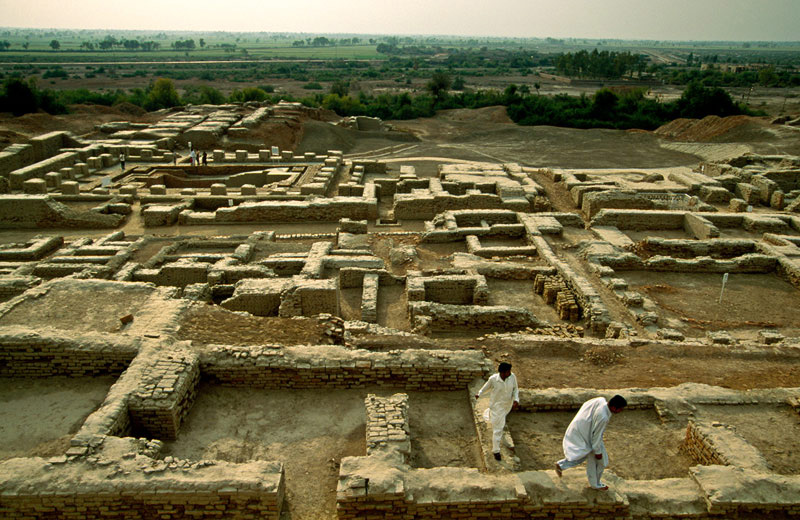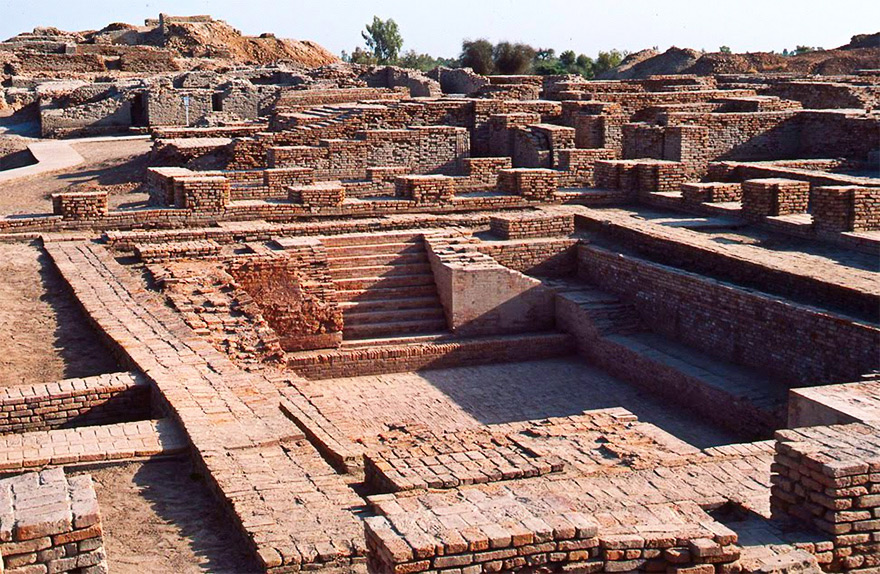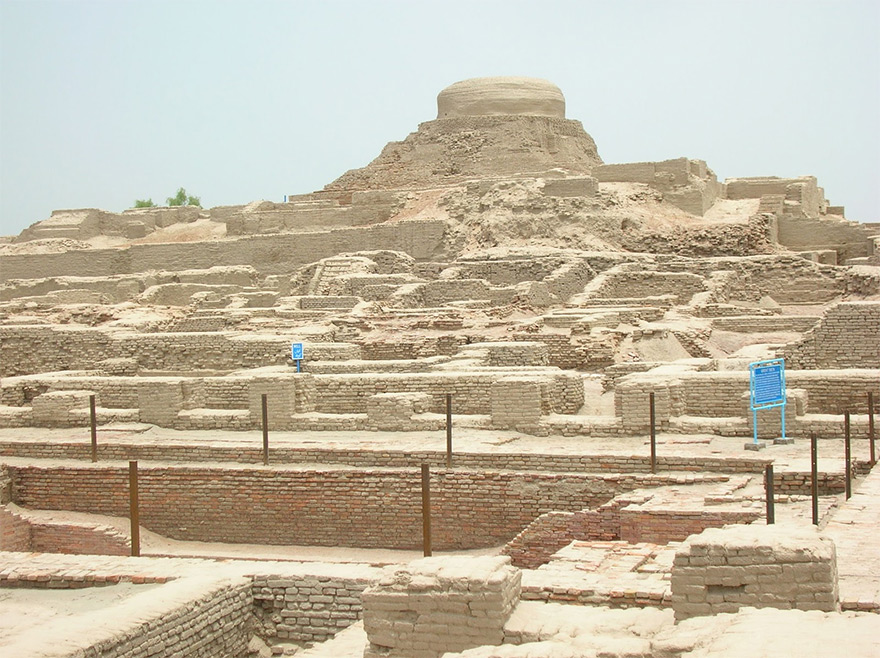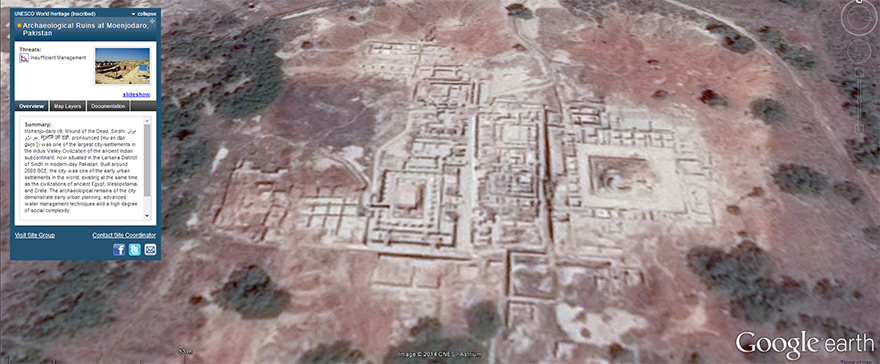
Moenjodaro (also spelled Mohenjodaro) is truly one of the world’s most incredible ancient cities. Believed by many to be the oldest and best-preserved urban ruin on the Indian subcontinent, this 5,000-year-old settlement is a testament to the great Indus Valley Civilization, featuring an intricate layout, impressive brick architecture, and advanced water and sewage systems.
After being abandoned in the 19th century BC, Moenjodaro was rediscovered in 1922 by an officer from the Archaeological Survey of India, and significant excavations took place over the next several decades. To date, an estimated 10-30 percent of the site has been uncovered, but conservation efforts aimed at protecting these extraordinary findings have been highly inadequate.
According to a recent report by BBC News Magazine, an assessment by Dr. Asma Ibrahim, one of Pakistan’s most accomplished archaeologists, predicts that “the site will not last more than 20 years” without improved preservation measures. Many walls have already collapsed, while others are crumbling from the base up as a result of salinity in the ground water.
“It is definitely a complicated site to protect, given the problems of salinity, humidity and rainfall,” said Dr. Ibrahim. “But most of the attempts at conservation by the authorities have been so bad and so amateur they have only accelerated the damage.”
One ill-fated initiative has been to use mud slurry to cover all the brickwork across the massive site with hopes that the mud will absorb the salt and moisture. But after drying and crumbling, the mud has chipped off the ancient brick, while the decay continues underneath. Other parts of the site have seen whole original bricks replaced with brand new ones.

Moenjodaro was added to the UNESCO World Heritage List in 1980, but foreign tourism there has become increasingly rare, presumably due to Pakistan’s security problems. Some 40 precious artifacts, including copper and stone seals, were stolen from the site’s museum in 2002. These items were never returned.
The Indus Valley Civilization, which existed at the same time as those of ancient Egypt, Mesopotamia and Crete, is one of the most important and least understood early urban civilizations.
The preservation of major Indus sites like Moenjodaro and Rakhigarhi is critical to increasing our understanding of Indus society.
Mohenjo Daro: Could this ancient city be lost forever?
Pakistani officials say they are doing their best to save one of the most important archaeological sites in south Asia, Mohenjo Daro. But some experts fear the Bronze Age site could be lost unless radical steps are taken.
It is awe-inspiring to walk through a home built 4,500 years ago.
Especially one still very much recognisable as a house today, with front and back entrances, interconnecting rooms, neat fired brick walls – even a basic toilet and sewage outlet.
Astonishingly, given its age, the home in question was also built on two storeys.
But it is even more impressive to walk outside into a real Bronze Age street, and see all of the other homes lining it.
And to walk the length of it, seeing the precise lanes running off it before reaching a grand, ancient marketplace.
This is the marvel of Mohenjo Daro, one of the earliest cities in the world.
In its day, about 2600 BC, its complex planning, incredible architecture, and complex water and sewage systems made it one of the most advanced urban settings anywhere. It was a city thought to have housed up to 35,000 inhabitants of the great Indus civilisation.
While I was overwhelmed by the scale and wonderment of it all, my eminent guide to the site was almost in tears of despair.
“Every time I come here, I feel worse than the previous time,” says Dr Asma Ibrahim, one of Pakistan’s most accomplished archaeologists.
“I haven’t been back for two or three years,” she says. “The losses since then are so immense and it breaks my heart.”
Dr Ibrahim starts to point out signs of major decay.
In the lower town of Mohenjo Daro, where the middle and working classes once lived, the walls are crumbling from the base upwards. This is new damage.
Map of Pakistan locating Mohenjo Daro
The salt content of the ground water is eating away at the bricks that, before excavation, had survived thousands of years.
As we move to the upper town where the elite of the Indus civilization would have lived, and where some of the signature sites like the large public bath lie, it appears even worse.
Some walls have collapsed completely, others seem to be close to doing so.
“It is definitely a complicated site to protect, given the problems of salinity, humidity and rainfall,” says Dr Ibrahim. “But most of the attempts at conservation by the authorities have been so bad and so amateur they have only accelerated the damage.”
One method used has been to cover all the brickwork across the vast site with mud slurry, in the hope the mud will absorb the salt and moisture.
But where the mud has dried and crumbled, it has taken with it fragments of ancient brick, and the decay goes on underneath.
There are even parts of the site where millennia-old bricks have been replaced with brand new ones.
“In a way, it is testament to Mohenjo Daro that it is still standing, given everything that has been thrown at it in the last few decades in the name of conservation,” says Dr Ibrahim.
Even the Mohenjo Daro museum has been looted, with many of its famous seals (thought to have been used by traders) among the artefacts that were stolen. They have not been recovered.
A guide at the site says he too has seen the dramatic changes in its condition and upkeep.
And while Pakistani visitors do still come on public holidays, he says very few foreign tourists visit Mohenjo Daro now. He suggests that might be because of Pakistan’s security problems.
Given the damage being done to this World Heritage Site, a poor tourism strategy has become the least of its troubles.
It was the government of Pakistan that was in charge of Mohenjo Daro for decades, but recently responsibility was handed over to the provincial authorities in Sindh. They have now set up a technical committee to rescue the site.
“We need urgently to listen to experts from all fields to save Mohenjo Daro,” says Dr Ibrahim.
“Yes, there is salinity, but local farmers have worked out how to overcome that problem so why can’t we? But we have to do something soon, because if things carry on like this, in my assessment, the site will not last more than 20 years.”

One saving grace may be that some of the city remains unexcavated and so remains protected.
Some experts have gone so far as to suggest the entire site should be buried again to halt its decline.
It is a sign of the desperation of those who love Mohenjo Daro, and who are pained to see a city that once rivalled sites of its contemporary civilisations in Egypt, Mesopotamia and China, losing its glory in this undignified way.
Authorities look away as plunder of Mohenjodaro continues
Authorities appear to be dragging their feet in preventing the pilferage of precious artefacts from the Mohenjodaro site, according to an official document.
A revised master plan for conservation and promotion of cultural tourism at the Mohenjodaro site awaits the federal government’s nod at a time when President Asif Zardari and PPP senior vice-chairman and Prime Minister Yousuf Raza Gilani are at the helm of affairs.
But the Mohenjodaro site, falling under the federal government’s jurisdiction, is regrettably facing a double whammy: non-stop pillage of antiques and severe seepage and damage, reveals the document made available to The News.
Major features of the revised master plan are archaeological conservation, acquisition of land, further excavation and conservation, landscaping and environment development, a tourism monument plan and an interpretation system.
Additionally, it provides audio-guided tourist movement, construction of a model on-site museum, a tourist complex for overnight stay, construction of boundary walls, a regular power and water supply plus an ethno-archaeological park.
The ministry of culture had rejected the original plan requiring funds worth Rs6,500 million in five years for the development of the site, with instructions to officials at the site to bring it down to one-third.
“The revised one is also lying pending as only routine funds are being released,” one official revealed. The Antiquity Act of 1975, which provides for protection of and legal cover to archaeological and historical sites, is not being implemented, as far as the world’s one of the oldest civilisations at Mohenjodaro is concerned, the officials explained.
“While the law stipulates that no trespassing can be done within 200 meters around a monument, in practice there is trespassing in the surroundings of most of the monuments,” reads the revised master plan, prepared by Mohenjodaro officials working at the site and provincial authorities at Sindh.
A summary of the master plan was dispatched to the federal government for approval after reducing the cost but nothing in practical is insight to ensure stoppage of flux of antiques from the site and save it from damages due to seepage, official sources said while handing over the master plan copy to this correspondent.
The document links non-implementation of laws and paucity of funds to the stealing and smuggling of precious artefacts and relics to other countries. “Due to trespassing, the monuments cannot be developed for attracting tourists and, therefore, strict implementation of the law is envisaged in MTDF to develop these culturally-rich sites for tourists.”
The plan emphasises promotion of cultural tourism. Preservation and restoration of the Mohenjodaro site, also on the world heritage list, is an ongoing activity and, therefore, the situation is ripe for steps to develop the site in a befitting manner, because the focus of donors is on this part of the world, which must be exploited for presentation of site for posterity to come.
At the very beginning, the Prime Minister Secretariat (Public Affairs Wing) UO No 01/JS (PA) 2008, dated May 13, 2008 instructed preparation of a comprehensive master plan that may be pursued by the ministry of culture. But despite its presentation and revision, the ministry does not seem to jerk into action.
The mid-term development framework of 2005-10 (original) envisaged an investment of Rs6.5 billion in culture, sports, tourism and youth affairs over a period of five years. With the world’s oldest civilisation, exotic mountain beauty and splendid seasonal variety, Pakistan has immense tourist potential.

But the key sector is still in early stages of development for a variety of reasons, including policy constraints, lack of infrastructure and inadequate tourist services. The mid-term plan provides that tourist arrivals and receipts are expected to grow at an annual rates of 10 and 20 per cent, respectively, to reach 850,000 arrivals and $500 million receipts by the year 2010 had it been approved and implemented from 2005-06.
The plan also envisages milestones such as building a world-call management scheme in the Pakistan expert advisory committee, which is committed to the success and funding of the Mohenjodaro development works.












pakistani govt should seek the help of ARCHEOLOGICAL SOCIETY OF INDIA to assist and conduct ‘SAVE HARAPPA (Hariyupa) and Mohenjodaro sites as ASI renovated ANGKORVAT FOR OVER 10 YRS….BUT security for ASI TEAM would be a gone case with Tehrik Taliban around…Only Allah can help us….may be some divine intervention will save this greatest of world heritage sights